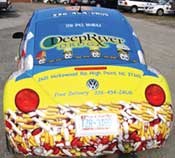Tradin’ Paint
Plastic films are replacing paint in some Automotive applications
In case you hadn’t noticed, the National Association of Stock Car Auto Racing (NASCAR) has come a long way from its back-woods, moonshine-runnin’ start 60 years ago. The sport, which draws millions of fans each year to races in multiple series, is now big business. At NASCAR’s top level, primary sponsors pony up seven figure annual budgets to work with the best race teams and most talented drivers.
Other teams use multiple sponsors to make up their racing budgets, featuring, for example, a pharmaceutical company one week, a new movie release the next and a financial services company the next.
You might think that would keep a lot of paint shop employees busy—and that’s not even considering the possibility that the car could wind up demolished at just about any point during a race weekend.
But you’d be wrong.
Those colorful graphics aren’t paint, they’re actually digitally printed vinyl films applied to the car bodies by specialty companies such as Motorsports Designs Inc. (High Point, NC). According to the company’s Nick Woodward, Motorsports Designs has been wrapping race cars since 1996, when legendary driver Darrell Waltrip wanted a car that looked like it was chrome plated. “A wrap was about the only way to achieve that kind of look at the time,” Woodward says. “It took us three days to wrap the car with a shiny polyester film.”
How times have changed. Motorsports Designs now designs and applies its RaceWraps to cars for several teams in NASCAR’s Sprint Cup series, including Roush Fenway Racing, Richard Childress Racing, Penske Racing, Dale Earnhardt Inc. and Petty Enterprises. Wrapping is no longer the exception, it’s the rule in NASCAR’s top racing series.
According to Woodward, the technology really took off early in this decade when special paint schemes started becoming the norm. “Many teams would paint their primary car and not the backup,” Woodward says. “Wrap technology enabled the teams to simply primer the body, then wrap right over the primer. In many cases we even wrap right over top of existing paint and decals when sponsors are alternating from one week to the next.”
Another reason teams like the wrap technology is to reduce weight, Woodward adds. “The more times you paint the car, the more weight you add,” he points out.
The process starts when teams deliver a design to Motorsports Designs two to three weeks before a race. Alternatively, the company employs designers and can handle the entire process from start to finish.
“Our production artists take the design and break it down into templates for each car body style,” Woodward says. “Then they color match and print the wrap. Printing takes about an hour using a digital, solvent-based printing process.
“In some cases the teams install the wrap themselves; in other cases our installers take it to the team’s headquarters and install it.”
Woodward says his company works in two-man application teams. “A good team of applicators can wrap a car in less than three hours,” he says. “The wrap consists of panels for the roof panel, hood, deck lid, TV panel, two sides and the car’s nose. Wrapping starts with the roof, hood, deck lid and TV panel, then continues with side panels to tie everything together. The nose is always done last because it needs to overlap onto the sides.”
For teams with regular sponsors, a RaceWrap may last for three to five races. “But we rarely get asked the question of how long it will last,” Woodward says. “Either the car is wrecked or the sponsor changes or they cut the body off to try to improve aerodynamics.”
As this is written, Motorsports Designs employees are in the midst of their busy season. “Teams with regular sponsors like to have an inventory of 15–20 sets of wraps on the shelf, so we’re busy printing those,” Woodward says. “But what really keeps us busy is the car haulers, trailers and other team items.”
Commercial Applications
Wrapping NASCAR race vehicles, where money is basically no object and considerations like corrosion and UV protection are non-existent, is one thing. But what about applications that require more durability?
One of the larger aftermarket applicators of film graphics—and the parent company of Motorsports Design—is Vomela Specialty Co. (St. Paul, MN). Founded in 1947, the company’s printing capabilities include more than a dozen screen printing presses with formats up to 60 × 144 inches, in-line presses for up to six colors, 25 digital printing stations, several large-format digital printers and direct-to-substrate printing.
According to Kevin Kuznar, VP Technology & Business Development, film-based graphics are making inroads in a couple of commercial application areas. Two of those areas are in recreational vehicle manufacturing and in fleet graphics.
“Fleetwood, Winnebago, Forest River and other large RV manufacturers use the technology,” Kuznar says. “The RV industry understands that the appearance of the outside of the vehicle gets potential buyers to take a look at the inside. If they cut corners and don’t put a lot of graphics on the outside, people won’t go near them.”
Kuznar says this is especially true for larger and more expensive units. “For high-end RVs—40- or 45-ft units that cost from maybe $120,000 to $500,000—this technology is a no-brainer,” he says. “You really can’t put a high-end, detailed design on those things unless you have someone with an airbrush doing it, customizing each unit. That’s difficult to do in a production environment.
“But the way the film technology has developed, with the vibrancy of the inks and clear coats, it allows them to produce graphics that look almost painted. So this approach allows RV manufacturers to make their vehicles more attractive on a production basis.”
Kuznar says the wrap materials also provide some protection from corrosion, UV and wear. “Most of the graphics are made from 2-mil thick calendared vinyl film and use a clear coat,” he explains. “The clear coat is a 1.5- or 2-mil thick cast vinyl film, so you’re looking at a thickness of 3.5–4 mils.
“The clear vinyl is one of the most durable ways to do this process,” Kuznar adds. “Not everyone has screen printing capability. It’s more economical for many applicators to digitally print the base film, then use a laminator to encapsulate the graphic in the clear laminate. Another approach is to print the graphic on a base film using either screen printing or digital printing, then put a liquid clear coat over the film.”
In the fleet market, emphasis is on creating eye-catching designs that maintain their appearance for anywhere from a few weeks to several years. “Some fleet owners do complete wraps on 48- and 53-ft trailers,” Kuznar says. “The wraps are various types of films—everything from regular opaque vinyl to a reflective film that illuminates when a vehicle headlight hits it at night.
The wrapped fleet vehicles are often part of sophisticated marketing campaigns, with the cost of the graphics justified by the number of potential impressions they may generate for the company involved. “Some companies go as far as tracking impressions or number of views,” Kuznar explains. “They do this using global positioning system (GPS) units on the vehicles and traffic data supplied by transportation officials. They track the number of impressions a vehicle might make on potential customers in a particular geographic area at a particular time of day.”
One very large fleet operator that came to 3M Automotive cast film that we screen with three colors and then top with a liquid clear coat. The result is a durable graphic with five- to seven-year life.”
Another Type of Film
Vinyl films applied after the fact are not the only game in town when it comes to potential paint replacements for at least some applications. A slightly different technology is offered by Soliant LLC (Lancaster, SC). The company’s Fluorex paint films are applied to parts during the actual forming process, whether that’s injection molding, extrusion, thermoforming or compression molding.
The technology is gaining popularity with automotive OEMs looking to reduce costs and improve vehicle exterior quality with more durable finishes. Soliant says gravelometer and field tests show the paint films offer significantly higher chip and weather resistance than conventional paint.
Cost savings result from eliminating painting, because parts finished using the process are ready to be assembled right out of the mold. According to Soliant, the technology also allows automakers to achieve a variety of appearance and decorating options with the same tool and process.
Fluorex films are environmentally sound and sustainable, the company says. The thermoplastic films are recyclable, and, according to Soliant, demonstrated a 98% reduction in VOC emissions compared with traditional vehicle painting.
Films are available in a variety of grades, each optimized for a specific production process or application. For insert injection molding, for example, Fluorex 2000 and 3000 materials are available for plastic resins including ABS, ABS blends and polypropylene. The films are thermoformed using typical thermoforming equipment before placement in the injection mold for completion of the part. Other film grades are optimized for extrusion lamination, as a chrome finish replacement for plastic parts, for thick-sheet applications that use ABS or polyolefin sheets 1 mm thick or more and as capping films that provide a durable, weatherable clear topcoat for vinyl and vinyl fabrics, ABS, PC and PC blends and polyolefins.
The company currently offers 140 colors for automotive interior and exterior applications, and says it will match colors and create new ones to help customers differentiate their offerings.
According to Soliant, more than 40,000,000 parts finished using the paint film technology have been in the field over the last five years without issue. A recent application of the technology is on trim components for the new Mercedes C-Class vehicles manufactured by Daimler AG (Stuttgart, Germany). The vehicles feature roofing strips and greenbelt moldings extruded using the paint film to give them a high-gloss black finish combined with more durability.
Related Content
TTX’s Automated Conveyor Carrier System Offers Wireless, Flexible Operation
ACC system designed for reliable, consistent point-to-point movement of everything from small to heavy parts.
Read MoreCobot Enters Paint Industry With Safety at the Forefront
This collaborative robot is the first explosion-proof solution for the powder coating and paint arena that meets the U.S.’ stringent safety requirements. Its lead-through teach programming and tablet control are especially appealing to small shops with little proficiency in robotics.
Read MoreConveyors and Paint Systems
Choosing the right conveyor system, coating technology, and ancillary equipment.
Read MoreConcrete Reinforced Bars Built to Last
Not all corrosion-resistant materials for infrastructure are created equally. Epoxy-coated steel rebar has advantages that other materials used to prevent corrosion do not.
Read MoreRead Next
Education Bringing Cleaning to Machining
Debuting new speakers and cleaning technology content during this half-day workshop co-located with IMTS 2024.
Read MoreA ‘Clean’ Agenda Offers Unique Presentations in Chicago
The 2024 Parts Cleaning Conference, co-located with the International Manufacturing Technology Show, includes presentations by several speakers who are new to the conference and topics that have not been covered in past editions of this event.
Read MoreEpisode 45: An Interview with Chandler Mancuso, MacDermid Envio Solutions
Chandler Mancuso, technical director with MacDermid Envio discusses updating your wastewater treatment system and implementing materials recycling solutions to increase efficiencies, control costs and reduce environmental impact.
Read More















.jpg;maxWidth=300;quality=90)








